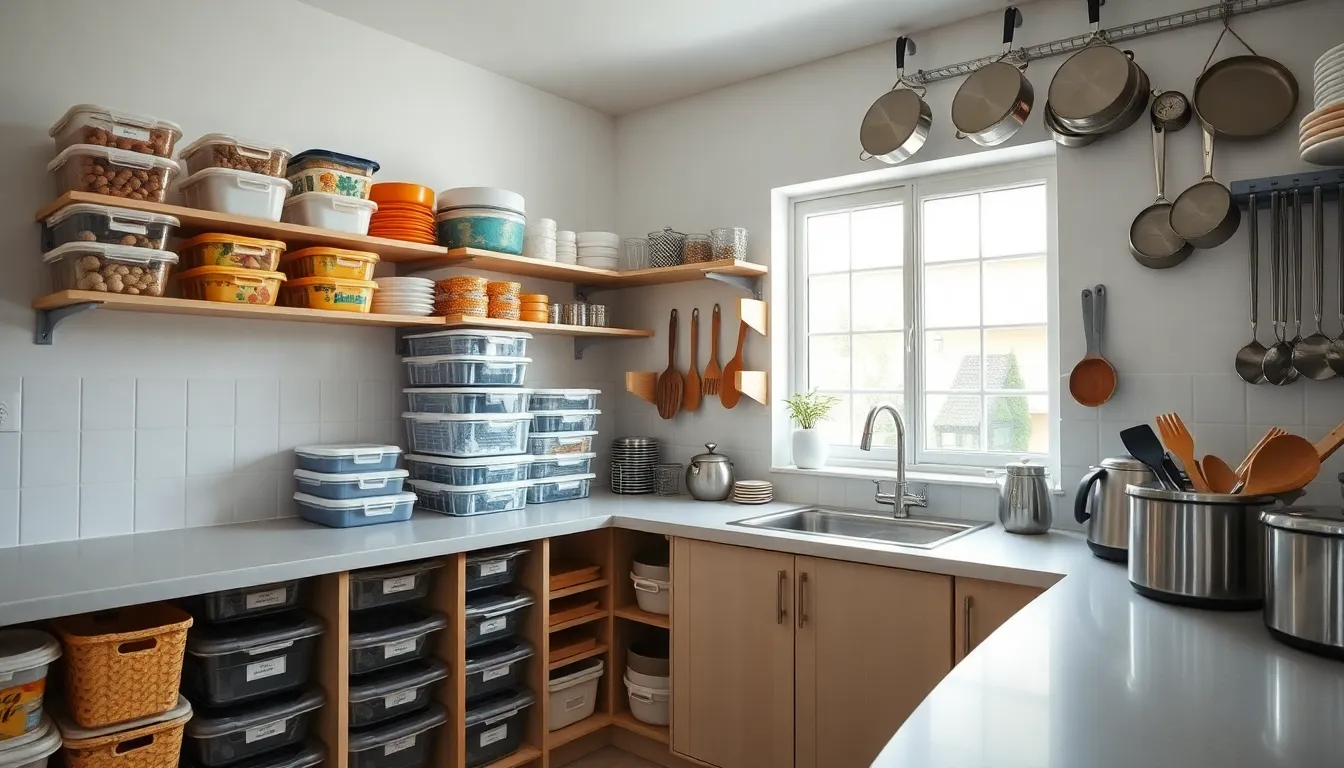Cooking at home can feel like a high-stakes game show where the prize is dinner and the penalty is a kitchen disaster. But fear not—becoming a home chef doesn’t require a culinary degree or a secret family recipe. With a sprinkle of creativity and a dash of confidence, anyone can whip up delicious meals that impress family and friends.
In this article, he’ll uncover essential tips that turn the kitchen into a playground rather than a battleground. From mastering the art of seasoning to avoiding the dreaded soggy bottom, these insights will help transform even the most reluctant cooks into culinary wizards. So grab your apron and get ready to elevate your home cooking game—because who says you can’t have fun while making a meal?
Table of Contents
ToggleEssential Home Chef Tips
Experimenting with ingredients boosts creativity in the kitchen. Try using fresh herbs instead of dried ones; fresh basil and cilantro enhance flavors significantly. Selecting the right tools also makes cooking easier. A sharp chef’s knife and a sturdy cutting board streamline prep time.
Seasoning properly transforms dishes. Start with salt and pepper, then layer in spices like cumin or paprika for depth. Adjust seasoning throughout cooking to ensure balanced flavors.
Measuring ingredients accurately provides consistent results. Use measuring cups and spoons for dry and liquid ingredients. Purchasing a kitchen scale helps ensure precision for baking.
Mise en place, meaning everything in its place, simplifies cooking. Prepare and organize all ingredients before starting. This practice minimizes stress and makes following recipes smoother.
Practicing knife skills enhances prep efficiency. Learning to chop, slice, and dice uniformly improves presentation and cooking times. Attend local cooking classes or watch online tutorials for guidance.
Understanding cooking techniques is crucial. Grilling, sautéing, and roasting each offer distinct flavors and textures. Familiarize yourself with methods to build confidence in various recipes.
Lastly, cleaning as you cook prevents overwhelming messes. Utilize a bowl for scraps and wash utensils while waiting for pots to boil. This habit promotes a more enjoyable cooking experience.
Kitchen Organization Techniques

A well-organized kitchen simplifies cooking and enhances creativity. Organizing spaces leads to efficiency and reduces stress while preparing meals.
Decluttering Your Cooking Space
Start by removing items not used frequently. Assess gadgets, utensils, and appliances; keep only what adds value. Donate or toss unused items to create an open atmosphere. Allow easy access to essential tools, such as mixing bowls and measuring cups. Visualize the flow of your cooking process; arrange frequently used items within arm’s reach. This method minimizes distractions and increases focus during meal preparation.
Effective Storage Solutions
Utilize containers for ingredients to maintain freshness and visibility. Stackable bins make the most of vertical space inside cabinets. Label containers to quickly identify contents, ensuring easy access while cooking. Consider adjustable shelving to accommodate various items, maximizing all available spaces. Use drawer organizers for utensils, keeping everything in its place. Install wall-mounted racks for pots and pans, freeing up counter space while enhancing organization.
Cooking Techniques for Success
Cooking techniques play a crucial role in achieving culinary success. Mastering these methods enhances skills and builds confidence in the kitchen.
Mastering Knife Skills
Knife skills form the foundation of efficient cooking. Practice slicing, dicing, and chopping to increase speed and precision. Using a sharp knife improves safety and effectiveness. Various techniques like the claw grip protect fingers while cutting. Regularly practicing different cuts, such as julienne and brunoise, broadens culinary versatility. Additionally, understanding the appropriate knife for each task streamlines food preparation. Kitchen tasks become less daunting with honed knife techniques.
Understanding Cooking Methods
Grasping different cooking methods expands culinary repertoire. Familiarity with techniques like grilling, roasting, and sautéing enhances flavor and texture. Grilling imparts a smoky taste, while roasting develops complexity in sweetness. Sautéing, on the other hand, quickly cooks food, preserving nutrients and vibrancy. Each method suits specific ingredients and dishes. Experimenting with combinations also brings creativity into meals. Knowing when to apply each technique ensures consistently delicious outcomes. Embracing a variety of cooking methods contributes to skillful home cooking.
Ingredient Selection and Preparation
Ingredient selection directly impacts the success of home cooking. Paying attention to freshness and quality enhances flavors and overall meal satisfaction.
Choosing Fresh Produce
Select seasonal fruits and vegetables for peak flavor. Fresh produce often features vibrant colors and firm textures, signaling quality. Visit local farmers’ markets or grocery stores known for fresh inventory. Inspect produce for bruises or blemishes, as this indicates age. Smell fruits and vegetables; their aroma usually suggests ripeness. Opt for organic options when possible to reduce pesticide exposure. Prioritize items that align with personal recipes and dietary preferences for maximum enjoyment.
Importance of Quality Ingredients
Investing in high-quality ingredients pays off in flavor and nutrition. Quality meats often exhibit marbling, indicating tenderness and rich taste. Fresh herbs elevate dishes, bringing brightness and depth to meals. Canned goods, such as tomatoes or beans, should feature minimal additives for healthier options. Oils and vinegars impact taste significantly; choose extra virgin olive oil for its robust flavor. Selecting whole grains over processed options boosts health benefits. Prioritize these choices to significantly enhance culinary outcomes in home cooking.
Flavor Enhancements
Flavor enhancements elevate the overall taste of home-cooked dishes, making them more enjoyable and memorable. Utilizing a variety of techniques can lead to delicious results.
Spices and Seasonings
Spices and seasonings serve as the backbone of flavor in cooking. Start with essentials like salt and pepper; these basics create a solid foundation. Add garlic powder and onion powder for depth. Experiment with herbs like oregano and thyme for aromatic notes. Consider incorporating chili flakes or paprika for a touch of heat. Layering flavors by introducing spices in phases makes dishes more complex. Understanding the unique profiles of spices enables chefs to create vibrant tastes while allowing creativity to shine.
Marinades and Sauces
Marinades and sauces infuse meats, vegetables, and grains with flavor. Begin by mixing oil, acid, and seasonings for a balanced marinade. A simple combination of olive oil, lemon juice, and garlic enhances grilled chicken. Allowing proteins to marinate for at least 30 minutes deepens the flavor. Sauces like pesto or chimichurri can transform a simple dish into something extraordinary. Creating a sauce with fresh herbs, nuts, and cheese adds richness and complexity. Experimenting with various flavors encourages the development of unique, signature dishes.
Embracing the journey of becoming a home chef opens up a world of creativity and flavor. With the right mindset and a few practical tips anyone can transform their cooking experience. By focusing on ingredient quality organization and proper techniques home cooking becomes less daunting and more enjoyable.
Experimentation is key so don’t hesitate to try new spices and cooking methods. A well-organized kitchen not only boosts efficiency but also enhances the cooking process. As skills improve so does confidence in the kitchen. With these insights anyone can elevate their culinary game and discover the joy of creating delicious meals at home.

